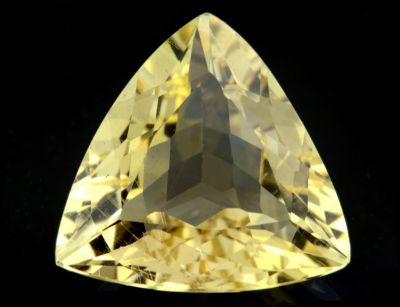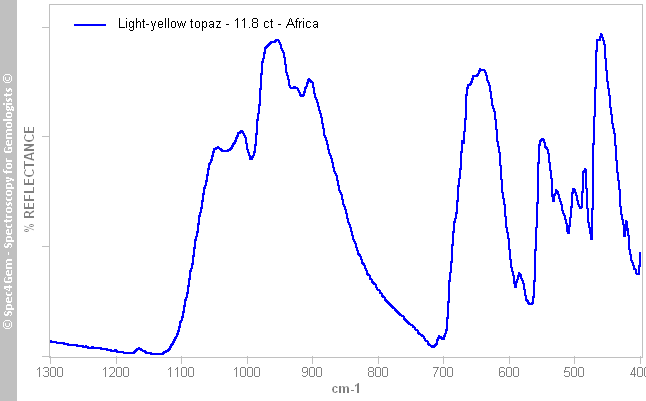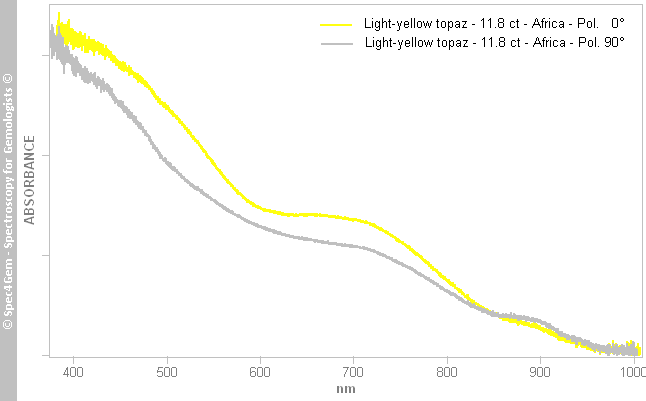Unusual 11.8 ct light-yellow topaz reportedly from Africa
- Details
- Created: Tuesday, 30 January 2018 10:58
Topaz is a well-known gemstone available in a wide variety of colors such as brown, yellow, light-blue, blue, orange, pink, red, purple and colorless. Even if brownish and yellowish topaz is quite common, yellow topaz (figure 1) is not as wide-spread as the others. It is rarely available in the market and rarely mentioned in the literature as a known color for topaz.
Some of these colors are natural, while others are produced by treating pale or colorless topaz with heat, radiation, or even metallic coatings. The most popular topaz is the blue topaz obtained by radiation and heating, lighter blue naturaly occurs in nature. Light-blue, orange, pink and red are rare and more valuable.
Synthetic topaz (hydrothermal process) has been produced but it does not flood the market because of the low price of the abundant treated material.
 Figure 1. This 11.8 ct topaz shows an attractive light-yellow color.
Figure 1. This 11.8 ct topaz shows an attractive light-yellow color.| Shape | trillion cut |
| Size | 15.2 x 15.0 x 15.0 x 7.6 mm |
| Color | light-yellow |
| Lustre | vitreous |
| Weight | 11.8 ct |
| SG | 3.56 [3.48 - 3.59] |
| RI | 1.610 - 1.620 [1.605 - 1.645] |
| DR | 0.010 Biaxial 'negative' [0.007 - 0.011 B+] : shows a negative optic sign for only 0.001, reading error ? |
| Pleochroism | weak from very light-yellow to light-yellow |
| Polariscope / Conoscope | light/dark 4 times / 360°, biaxial interference pattern observed from the culet (table downside) |
| SWUV | inert |
| LWUV | inert |
| Magnetic susceptibility N52 | diamagnetic |
| Chelsea filter | light-yellow |
Table 1. Observational and measured properties
Infrared reflectance spectroscopy:
The IR reflectance spectrum (figure 2) was acquired from the stone's table. The spectrum pattern is consistent with topaz spectrum.
 Figure 2. The IR reflectance spectrum of this 11.8 ct light-yellow topaz is consistent with topaz spectrum.
Figure 2. The IR reflectance spectrum of this 11.8 ct light-yellow topaz is consistent with topaz spectrum. UV-VIS-NIR spectroscopy:
The UV-Vis-NIR spectra (figure 3) were acquired with the light path entering the stone at the culet and exiting throug the table. A polarizer was used to get polarized spectra, topaz should show three spectra since it is biaxial. Only two of them were collected and identified as Pol. 0° and Pol. 90°.
 Figure 3. Polarized UV-Vis-NIR spectra of the 11.8 ct light-yellow topaz showing weak pleachroism and possibly radiation defects as color cause.
Figure 3. Polarized UV-Vis-NIR spectra of the 11.8 ct light-yellow topaz showing weak pleachroism and possibly radiation defects as color cause.The two spectra are almost identical except slighly more prominent features in the Pol 0° spectrum. The slight difference explains the weak pleochroism and the same hues for the pleochroism's colors.
The pattern looks like a combination of two bands, one around 700 nm observed in blue topaz and one around 450 nm observed in brown topaz. The difference with the blue topaz is that the 400-500 nm range of the spectrum shows a strong and broad band although it is only a weak and narrow band in the blue topaz. This difference explains the color difference, because of the transmission of the blue or not. In the blue topaz the blue is transmitted while it is not in the yellow topaz.
The 700 nm absorption band is known to be caused by radiation defects in the blue topaz, similarly this is likely the same cause for this yellow topaz. Radiations cause topaz to become brown or yellow but this color is unstable and returns to colorless while exposed to light. It would be interesting to expose this stone to sun light for a while and check the color after that, stable or unstable color, the question can be raised. With only one piece in hand, the game is a bit hasardous!
Photoluminescence spectroscopy:
No luminescence with the 405 nm laser source.
Conclusion:
This light-yellow topaz exibits an attractive color which is likely the result of radiation defects. The question about the color stability has not been answered yet!

